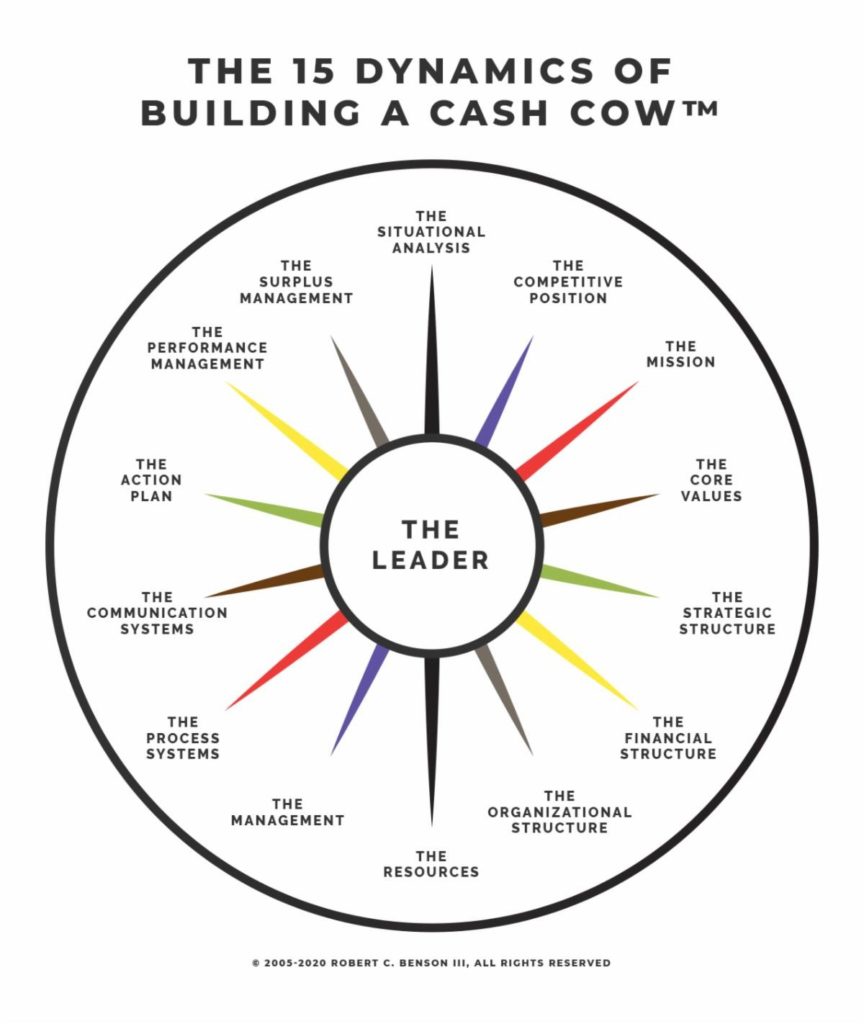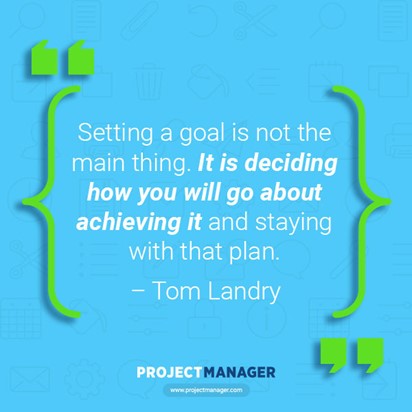The 15 Dynamics of Building a Cash Cow™ PART 6
THE STRATEGIC STRUCTURE
I am writing a series of articles on The 15 Dynamics of Building a Cash Cow™. Most of the articles, including this one, are applicable to both profit and non-profit companies. In this article, we will look at The Strategic Structure of a company. Why? You will see the value as you read about this dynamic.
Recap
IN THE INTRODUCTION, I presented The Driving Principle that “all data is not equal.” Ralph Waldo Emerson noted that “The value of a principle is the number of things it will explain.” Why? Because it is transferable to many applications and realms of our life and business. Then I discussed an insight that is even more powerful: “The value of a Driving Principle is the number of things it will do for your company.” Applying them will transform the company.
IN PART 1, THE LEADERSHIP, I created the awareness of The Driving Principle: “The leader’s belief system determines the effectiveness of the leader and the company.” Faulty beliefs, of which there are many in the business world, like “formal business planning is a waste of time,” significantly limit your profits and growth.
IN PART 2, THE SITUATIONAL ANALYSIS, it was noted that a sound business plan begins with a situational analysis. The Driving Principle: “To know where you are going, you must first know where you are.” Therefore, we provided the readers with methodologies to perform a competitor analysis, a SWOT analysis, and an external forces analysis.
IN PART 3a & 4a, THE COMPETITIVE POSITION, you learned that there are three Core Competitive Strategies and only three! Then you learned there are 16 Grand Strategies. The Driving Principle of each of these is “Pick one and give total commitment to it!” Then we demonstrated how to use them to design a competitive position to take you to the next level.
IN PART 4, THE MISSION STATEMENT, you learned that an effective, clear, and inspirational mission statement is comprised of three components: the Vision, Diving Principle – “Without a vision, the people perish”; Mission, Driving Principle – “Without a goal, you can’t score”; and Purpose – Driving Principle, “People do things for their reasons, not yours.”
IN PART 5, CORE VALUES, you learned that the benefit of core values is they perpetuate the values you want to be established throughout the organization as it grows.: the Diving Principle? What you feed, grows.

What the leader believes to be reality is reflected and integrated in the company through his/her behavior and decisions. I know it is intimidating, but Consider how the beliefs of a U. S. President affect our country, and what a governor has on you and the state you live in. Think about the impact leaders of the companies you have worked for had or have on the companies. And the impact your parents had/have on you and your family? My objective is to empower you with sound Driving Principles.
Driving Principles have the power to drive the culture, growth, profits, cash flow, and overall success of your company to the next level and beyond to the top 25% of your industry. Even if you are profitable and growing, if your company’s financial performance is not in the top 25%, it is underperforming. On average, the top 25% of companies make about twice as much profit as the middle 50% and about three times as much profit as the average company. I hope you enjoy putting these Driving Principles to work in your company.
Case Study
AFC had an exceptional reputation for quality and service. They had been in business for seven years and were growing every year with a compounded growth rate of 48%. However, they had only accumulated about $200,000 in retained earnings. To finance the growth AFC had amassed over $1.5 million of debt, about $1 million of which was a high-interest rate loan. They had several strategic structure issues. The actions we took and the results are set forth in this article.
“Unless a commitment is made, there is only promise and hopes; but no plans.”
Peter Drucker
What is The Strategic Structure?
Businesses have structures, just like buildings do. So first let’s look at a building structure. There are 15 basic components of most buildings that are built for people to work or live in, in no particular order: 1) Foundation, 2) Beams, 3) Plinth Beam, 4) Floor, 5) Columns, 6) Walls, 7) Roof, 8) Parapet, 9) Lintels, 10) Stairs, 11) Plinth, 12) Damp-proof course (DPC), 13) Electrical, 14) Plumping, and 15) HVAC. Every building has to be engineers to meet the objectives, needs, desires, and size demand of the user(s) and the legal laws, specs and natural/science forces and laws. As you can imagine, these items change, from building to building. If they are not engineered properly, the building can have problems, sometimes serious problems, or do not meet the intended objectives, needs, desires, or requirements.
In our early years when we lived in MN, my wife and I bought a house on a lake near 3M. We needed more space for our family and other objectives, so we hired a contractor to add a second floor to the home. Of course, we asked if the foundation could hold the additional weight and they assured us it could. About two years later we decided to move to CO and sold the home to friends. A year or two later the house started to sink. Fortunately, the contractor was a person of integrity and told the owners he would take care of the issue at no charge. To fix the problem, he pumped up the house and increased the foundation to carry the additional load.
Strategic structures, many of which are comprised of intangible structures, are comprised of strategies and objectives. All of which has to be engineered to meet the objectives, needs, desires, and size demands of the owner(s) and company. And yes, they also have to be engineered with consideration of legal laws, specs, and natural/scientific forces and laws. However, unlike a building, a company is not stationary while you build it, so it is akin to constructing a building while it is rolling down the street.
Like buildings, companies have 15 basic structures: 1) The leader’s belief system and its development and structure; 2) The industry structure, forces, and your position and mission in it; 3) The corporate culture core values structure; 4) The strategic imperatives structure; 5) The target objectives structure; 6) The financial structure; 8) The organizational structure; 9) The management structure; 10) The action plan structure; 11) The operations (product or service development, manufacturing, service or construction, etc.) structure; 12) The marketing and sales process structure; 13) The accounting and administration structure; 14) The internal communications structure; and 15) The performance and measurement structure.
Building a Strategic Plan
“Putting your strategic structure in writing is what makes it tangible!“
Robert C. Benson III
The online dictionary defines strategic as “identification of long-term or overall aims and interests and the means of achieving them.” For example, “the company should take strategic actions to cope with fundamental changes in the environment.” In the case of business, “environment” means the economic environment and the industry you are competing in within that environment.
In the dictionary, strategy is often used in warfare, “the art of planning and directing overall military operations and movements in a war or battle, often contrasted with tactics” used to accomplish the strategy. Although business is not a war, in the business world you face can many battles (struggles and conflicts) that impact your profits and growth. For example, one of my former clients sold headwear in the golf industry and was doing so well one of the biggest competitors in the nation became threatened by their success and retaliated in a way that greatly limited their success. The construction industry can become very cutthroat in economic times. I have witnessed over several economic downturns how a properly engineered strategic plan can sustain a company’s success and even allow it to thrive in a recession.
My articles on the first five dynamics of building a cash cow business have already laid out the initial four steps to building a powerful strategic plan: The Situational Analysis, The Competitive Position, The Mission, and The Core Values. They are imperative to properly engineering a formidable strategic business plan, even for small companies with under 500 employees. Without that foundation, the last two steps contained in this article will be helpful but not nearly as effective. If you have done that you are ready to effectively finalize your strategic plan.

Selecting Strategic Imperatives
To effectively accomplish your Mission Statement and realize your Competitive Position, the next step is to establish strategic imperatives. About seven to ten of them should suffice. To start with, look at the key items in each section of your SWAT analysis. What are the success factors that got you to where you are or were (before COVID)? Remember, the 15 dynamics I am writing about are called dynamics because they are changing and affecting all or part of your business as you are in motion and growing. Your key success factors, for example, might be quality or exceptional customer service, must be effectively sustained as you grow to maintain your reputation. Your key weaknesses must be overcome. Your key threats have to be addressed. And key opportunities must be pursued. All this while you are rolling down the street, so to speak.
For example, about 15 years ago I facilitated the leadership team of a university in establishing a formal strategic business plan (like I am suggesting you do). During the process, leadership realized that what had made the university successful had never really been formalized. Therefore, it became watered down over the years through changes in personnel, financial stress, and confusion that comes from growth, change in leadership. This confusion was facilitated by a lack of formal strategic imperatives – core strategies that must not change. As a result, their Strategic Imperative #1 – Provide a vibrant student-centered experience was formalized. And everything in the university was built around it with total commitment. They became a leader in their state and conference. Following is the rest of the strategic imperatives they established:
Strategic Imperative #1 – Provide a vibrant student-centered experience.
Strategic Imperative #2 – Deliver academic quality and rigor in our students’ pursuit of an education.
Strategic Imperative #3 – Promote a shared commitment to the University’s Vision.
Strategic Imperative #4 – Perpetuate financial viability.
Strategic Imperative #5 – Unite knowledge, reason, and Christian faith in curricular and co-curricular activities.
Strategic Imperative #6 – Challenge our students, faculty, and staff to be leaders of character who will maximize their talents for the common good
Strategic Imperative #7 – Inspire and empower our students, faculty, and staff to use their talents to serve God and humanity.
Strategic Imperative #8 – Build a population of students who fit the university profile.
Spiritual Strategic Considerations
The Bible teaches us that God exists and that He and His Son, Jesus Christ, created the universe. If you are not sure you believe that, you may enjoy reading Lee Strobel’s book, The Case for Miracles. By interviewing astrophysics experts, Strobel explains how scientists, including non-Christian scientists, have proven that there has to be a “higher power” outside the universe to create the universe. I highly recommend all Christians and non-Christians read this book. As always Strobel, a former investigative journalist, is very thorough in his research.
The Bible continues by teaching us that God created man and woman and they were “good”. God instructed them on how to live on earth and remain “good.” Eve and Adam disobeyed God after being tricked by a serpent (Satan, also referred to as the devil). As a result, they became separated from God, lost their goodness and purity, and evil entered the world along with the forces of evil. We learn from the Bible that God had a plan to redeem mankind and gave mankind a gift by sending His Son, Jesus Christ, to earth to die on a cross to pay the penalty for man’s disobedience. Jesus was also sent to teach mankind how to live on earth with access to God’s power. In the book of John in the Bible, Jesus instructs us that a person can receive this gift by believing in Christ and inviting Him into their life. He explains that through this process we become “born again” spiritually into God’s family and reconnected to God.
Of course, Satan and his forces of evil are still at work on earth trying to stop God’s plan. If one looks at the world with intellectual honesty, this battle is obvious. Therefore, there is a spiritual battle of the forces of good and evil on earth that affect our lives and our success. As such, in Ephesians 6:11-14, the apostle Paul instructs mankind as follows:

“Therefore put on the full armor of God, so that when the day of evil comes, you may be able to stand your ground, and after you have done everything, to stand. Stand firm…”
This battle and how to win it is in my book, Stand Firm With God’s Power in Business. You can buy it on Amazon. Or, if you can’t afford one, there is a free courtesy copy of it on the CCBA Website at www.CCBAlliance.org under the Resources tab. One of the synonyms of strategy is “scheme.” So, you see, Satan has strategies to derail your spiritual growth and success on earth. That includes your career and/or business. One of the dangerous parts of his scheme is that Satan is every bit as capable of “blessing you” with success and money as God is. In Matthew 4 he even tried to derail Christ with that temptation. Generally speaking, he does that by pursuing your spiritual immaturity and weaknesses or business immaturity and weaknesses. And he is very good at it!!!
“Again, the devil took him to a very high mountain and showed him all the kingdoms of the world and their splendor. 9 “All this I will give you,” he said, “if you will bow down and worship me.”10 Jesus said to him, “Away from me, Satan! For it is written: ‘Worship the Lord your God, and serve him only.’
How did Jesus battle with the devil? He simply quoted Scripture (from the Bible) to him. That is why the next CCBA Webinar Conference is on The Seven Pillars of Wisdom. See below for details. The Apostle Peter, in 1 Peter 5:8 instructs us to:
“Be alert and of sober mind. Your enemy the devil prowls around like a roaring lion looking for someone to devour.”
Establishing Target Objectives
The final step in creating your strategic business plan is to establish target objectives that enable the company to accomplish each strategic imperative. Target objectives, like strategic imperatives, are perpetual. They are not annual goals. They are perpetual objectives (which could be a perpetual goal). For example, in #8 above, a college might have a target objective of recruiting only students who are in the top 50% of their class or have attained a particular score on the college entrance exam.
Some companies establish financial target objectives. For example, reaching and sustaining a financial performance level in the top 25% of their industry. Target objectives should be measurable. And I have found that there is a way to measure just about anything, including customer satisfaction. If you have done a good job in establishing your strategic imperatives and target objectives, there should be no need to change them every year. If that happens, they are not target objectives, they are annual goals. However, there are times when one may need tweaking. Or, when industry forces (as we discussed in previous articles) change to the point where your formal strategic structure (in the form of your written strategic plan) must change to effectively continue to compete and thrive in your industry. You see, putting your strategic structure in writing is what makes it tangible!
Of course, it is not appropriate to give you examples of the target objectives of the university above. But you will get hints of certain target objectives various companies have established as the future articles become published. So now, you need to develop the target objectives you believe are needed to accomplish each of your strategic imperatives.
“For I know the plans I have for you,” declares the Lord, “plans to prosper you and not to harm you, plans to give you hope and a future. Then you will call on me and come and pray to me, and I will listen to you. You will seek me and find me when you seek me with all your heart.”
Jeremiah 29:11-13 NIV
YOUR VISION AND THE DRIVING PRINCIPLES
I encourage you to follow along as we examine the Driving Principles and beliefs fueling The 15 Dynamics of Building a Cash Cow™. When we are done you will have a valuable blueprint to build your business, increase profits and accomplish your vision and goals.
The series with PART 7, will begin sometime after the CCBA Webinar Conference on September 24, 2021. In PART 7 you will receive insights into The Financial Structure of a company that is sound and powerful in aiding leadership to work smart. These insights will help you sleep better and change your quality of life forever. At least, that is what numerous business owners have told me.
We expect this year’s webinar conference, THE SEVEN PILLARS OF WISDOM, on September 24, 2021, to be unique, useful, and productive in your work/business strategies and your personal and spiritual growth strategies. PLEASE SAVE THE DATE!
The Lord be with you and keep you safe!

If you have feedback or questions for Bob, email him at bob@CCBAlliance.org. For more information on The Colorado Christian Business Alliance go to CCBAlliance.org. If someone you know would like to receive these BobChats™ email the information to clancaster@abadvisors.com.
Robert C. Benson III (Bob) is the co-founder and past President/CEO of American Business Advisors, Inc., a Business strategic, finance, and management advisory firm specializing exclusively in the unique opportunities and issues faced by small and mid-sized companies. He successfully founded or co-founded seven businesses, including being a co-founder and former President of SecurCare Self Storage, Inc., now National Storage Affiliates (NSA), a public company and the 4th largest self-storage company in America. Bob is also the founder and former Managing Partner of the CPA firm, Benson Wells & Co, now Corne Jantz and Associates. Mr. Benson’s credentials include being a CPA*, Certified Management Consultant, and Chartered Global Management Accountant. He is also the author of STAND FIRM WITH GOD’S POWER IN BUSINESS and numerous business and spiritual articles. Bob is married and has two sons and four grandchildren.


